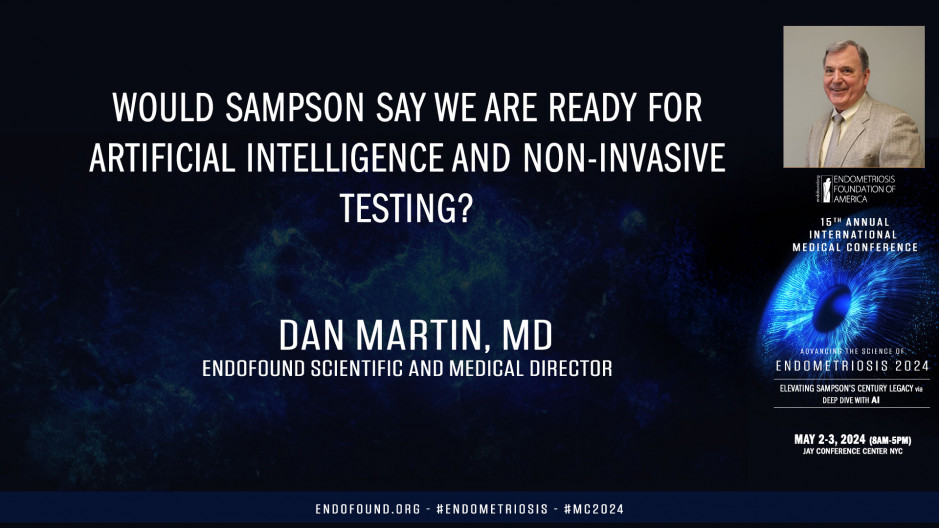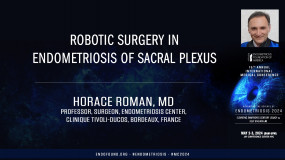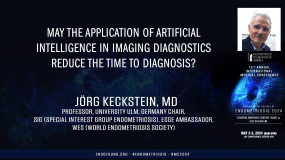International Medical Conference
Endometriosis 2024:
Elevating Sampson’s Century Legacy via
Deep Dive with AI
For the benefit of Endometriosis Foundation of America (EndoFound)
May 2-3, 2024 - JAY CENTER (Paris Room) - NYC
So we're going to continue orgs talk on artificial intelligence and expand this to Yes, what would Samson say? So I have no dis closures. There were a lot of learning objectives. The only one that's important is the one that's highlighted. Remember when we're talking about recognition, this is a surrogate measure. This is blue sky. It doesn't mean that we need to treat it. Recognition and treatment are two different subjects. We need more data on what it means to treat specific lesions.
We're going to talk about basic research, translational medicine, expert opinion and speculation. If we go back to 1899 and we look at which one, that one, and we look at Richard Russell's original discussions of hidden endometriosis. Remember, this is endometriosis. He didn't recognize this was an ovarian adenocarcinoma on the left side, right side, normal side, the outer pole surface covered with shreds of adhesions, endometriosis hidden beneath the adhesions, endometriosis hidden near the hilum. As far as I know, we don't have an MRIA sonogram. Anything else that is capable of seeing lesions at that size. What was missing from jogs, which is missing from every discussion I've heard on sonograms, is the range of the sizes of lesions that are being found, the median lesion that is being found, and a distribution of the lesions being found. Everything that I see looks like you're looking at two centimeter lesions and you're missing on awful lot of small ones.
We miss endometriosis all over the place. I'm going to show you some examples of those on the peritoneal surface. Retroperitoneum, you just saw the ovary, we miss it. All these other areas. We are not good at recognizing endometriosis in all patients. We're pretty good at peritoneum. We can see what's in front of our faces, what's not in front of our face that we miss. There are lots of ways to miss it. For those of you who don't understand. I rarely did bowel endometriosis laparoscopically. I use laparotomy through my entire life. I think that a surgeon who doesn't understand when he needs to do a laparotomy or at least a hand assisted laparoscopy so he can palpate is not competent in identifying endometriosis, and I understand that that goes at odds with half this room, but I think if you don't use something to try and palpate inside the abdomen, you're missing lesions that I found my entire life.
Things like Mark Passover and others. We have, whoops, wrong one to this one, this one, that one. There are people who find, well, one of these buttons is going to do it. We find people who find endometriosis dissecting. So these subtle occult peritoneal pockets and endometriosis found while they're dissecting areas. Mark Passover, who only finds him because he's done all of this interesting data that he does to find out where recognition is. All of these are reasons that we miss endometriosis. Things that we don't think about techniques are wrong. We still see videos of somebody taking a co coagulation, a vaporization unit and starting in the middle of the lesion and vaporizing it from the middle out. We did that in 1982 and realized by 83, this is the wrong approach. If you don't start on the outside and work in, you've got to mark the lesions from the outside and work in.
Otherwise you distort the outside so much you can't find it. Tamara will not like the fact that I have not fixed my slides yet. I still call these satellites because VC Butra called them satellites. This is multifocal endometriosis. This is the problem that David Redwine and I had, and I'll show you pictures of what I had remember in David Red Wine's 1991 paper of the 35 new diagnoses. He had 33 but were because of tunnel vision. He could go back and look at his old pictures and see these were lesions he missed because he wasn't looking at 'em accurately enough. So this tunnel vision is a big problem. Palpation, magnification, all those other things are important. This was my protocol. So those of you who've seen my study that got up to a 99% predictive positivity, remember it had a 14% negative positivity. So I had a lot that I missed, but that was a protocol that it took.
Nobody can do that in clinical practice. When I went back to clinical practice, I dropped from 99% back to 88%. You can't hold that kind of technology if you're doing research. I mean, you can do this in research. You can't do that in clinical practice. And then we get into want to make Paula and some way happy. We got to have some more markers provide fibrosis, too many green buttons in here for fibrosis. We have to have all these additional things. And then for inflammation, remember on real subtle lesions, you can't tell the difference between an inflammatory cell and a stromal cell. They look just alike. Need CD tens and other markers, other histochemical markers or we don't know how to do either.
Don't get some specifics of this. And Griffin of study 14 of the 16 cases of rect vaginal endometriosis they did had been missed at previous surgery. 14 of 16 missed at previous surgery. People who looked at 'em laparoscopically and missed it. Question is how many of these will imaging demonstrate? I'll show you one shortly. That imaging will demonstrate it's large enough, but how many of those will recognize it? How many of 'em are going to miss? Because until we know that they're capable of, remember we found plenty of palpable three to five millimeter nodules until they're capable of doing that routinely, then I'm not sure what we make of those. This is a study napkin ring lesion, and for those of you who don't understand napkin ring lesions, this looks like a cancer to a radiologist who looks at this. This looks like a cancer down here.
You got something sitting right there that doesn't belong right there. A hole in the bowel. So somebody calls me up after this bare minimum is done. The radiologist missed it. So this was missed on the original X-ray. They subsequently did a laparoscopy and missed it. They did a laparotomy and missed it. Then they referred, then they repeated the bare minimum and found that they found the same thing, but they didn't compare it to the original. They called me up because this is what we're talking about. Before they had told me that I had taught them, you don't get this in less than seven to 20 years. This takes seven to 20 years to develop. This is not an immediate development. This is something this size takes years to develop. And they called me up to tell me they'd found one in they found developed in two years.
So I said, have 'em review the films. Apparently the radiologist turned white because he thought he'd missed a cancer. So these massive sized lesions that people who are doing imaging, so when York talks about experts, I can have a medical student do this one if he's looking closely enough. We need something more than experts. We need people who are paying attention. This one, which I love is Philippe's paper. Philippe's image from 1989. We have a 15 millimeter nodule right there, easy to palpate. Philippe picked it up on clinical exam. He knows it's there. He knows where it is. He could palpate it and map it so he knows when he goes in, he knows that's where he is going to look. And after he dissects, that's what he sees. 15 millimeter nodule. Sonograms can pick that up. MRI can pick that up. Physical exam can pick that one up.
Someone who's doing a good retro cervical exam will have no trouble finding that one if you don't do it. Remember, the current wrf thing doesn't include retro cervical exams. I'm not sure they're going to miss this thing on that technology, but that is something that imaging's capable of picking up until it gets to a certain lesion. I keep hoping they can see a five or smaller lesion like this. One little endometrioid nodule from den, this is Leonard's group. They found it on sonogram. They went into the laparoscope or had a normal uterosacral ligament and with a normal uterosacral ligament, they decided to excise the uterosacral ligament and that was endometriosis. So we have lesions like this that we know that we can see now. Yes, I promise you I can make this thing work right there. We can see these five millimeter lesions on the uterosacral, but we need to know how often is this and it's just just an oddity.
We know that imaging been adequate, was inadequate for 15 liters in 1989 would've been, I don't know if you, did you use imaging on that one, Philippe or not? We weren't even using imaging then were we? That napkin ring lesion, they missed that. Now we have that sonogram for the hidden uterosacral Li we found and we now have lardis found us some two to four millimeter peritoneal lesions. But as far as I know, other than occasional incidental two to four millimeter lesions, we don't have any data more than that. Again, I've got to fix my slide before Tamara shoots me. These are multifocal endometriosis, not satellites.
VC butra thought we should do one to two centimeter margins to make sure we got them because he said they were hard to find. Larry Demco found pain 27 millimeters away from the peritoneal lesions. He could see duko et al and Roman and Al found hidden satellites up to six centimeters from a primary bowel lesion. And in SKU's original study, she had up to 36 hidden lesions in and around the originals as an example. This is one. Most of you have seen this picture a million times. How many of you have seen this dark scarred lesion right there? How many of you recognized is it a dark scarred lesion? But if you look at it closely enough, that is a dark scarred lesion and you can barely see the darkness in it. There's a little dark area here and I can't see it on this slide, but I can see it in the originals.
That is a dark scarred lesion. The chance that's endometriosis approach is a hundred percent. But what we didn't see on that side is there's a little vesicle down there, little bitty fibrotic lesion here. Those are all endometriosis and all these abnormal areas, little vascular abnormalities. Everything else in here doesn't look right. And in albe series, 24.3% of abnormal areas were endometriosis. So when we start programming these artificial insemination things, artificial intelligence things, we've got to program not only the things we know how to describe, but also these other subtle abnormalities. We have to be ready not for the six descriptions in the SRM, the 20 descriptions I had in my study, but we have to be ready for all 68 that we found in 16 different studies that we analyzed to see how many different descriptions there were. So there are 68 different unique descriptions. Excuse me, not unique. All overlapping on different ways people see things.
I was able to get down to 200 microns. We had glands and Strom on a 400 micron glands only on a 200 micron. I wish I had a CD 10 on the base of that, but I don't. But in addition to being able to see down to 200 microns clinically when we blew this up in the lab, we can see as small as 80 microns sitting right there. Do I know what that 80 micron lesion is? I don't know. It could be an artifact in the picture. Could be an inflammatory risk, could be endometriosis, could be cancer for all I know because all I know is it's there, but I don't know what it is. Tamara, when he showed that slide yesterday, one of the lesions in his was 30 microns. That's at the two to three cell size. We need some way to technically tell what those things are. So in order, they are just to be able to recognize them and as I said in the beginning, after we recognize them, then we have to prove that means something. Recognition is still blue sky. That's not translational. We need somebody to do the translational work that shows that what we can recognize means something clinically.
So we're going to get improved outcomes from artificial intelligence and all of those things that it can do. Some of the biggest are you don't worry about how much learning curve somebody's own because the computers are going to be learning curve at the top all the time. We're going to have all these concerns. I think the fallacious extrapolation was the one that hit me the most in the beginning. That was the one when you ask it to give you PubMed citations for papers, it did the same thing to PubMed citations that it did to text. When you turn it into a limerick, a haiku, any other kind of prose poetry, it rearranges the citations. I ask it for citations. It gave me my citations written by Cameron Najat and vice versa. It gave me citations that did not exist. It did the same thing to legal citations.
They disabled that module about six months ago because it was such a big national disaster for them. But all these other problems, and the one that I didn't understand was this one. Nobody in this room has a trouble seeing that stop sign. Does anybody in the room have a trouble seeing that? That's the same stop sign. Artificial intelligence cannot tell the difference. Excuse me. Artificial intelligence misses the second one. Artificial intelligence trained on this one cannot see this one. It's the same problem that that Tesla had that went after one of those silver 18 wheel trucks that picked up the blue sky reflection on the side of the truck and read the sky and now does a truck. You got to watch for these things. These things are going to take a lot of work to work. For conclusion one, we've got to be happy to watch for our learning curves and what we feed into them.
We have tunnel vision so we're not finding everything. We hope that we can tell it how to find them. The satellites, the multifocal, the small lesions, they are going to be able to help us with physician fatigue. So we don't worry about a physician who's been working for 16 hours all of a sudden worrying out and not being able to see where he is. The time sensitivity to development of everything. The computer models are going to see things without worrying about that and they will be continuously learning. We have a lot to work with. We've got to get biomarkers in there, the historical surveys, all those other things we have to do. They do need to be a part of comparative research and we need to be prepared for what we're going to do if it really works. I think Samson would say, right now we're not prepared. Thank you.










